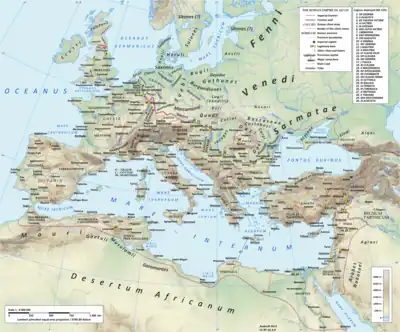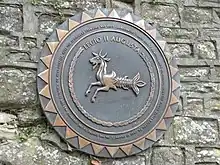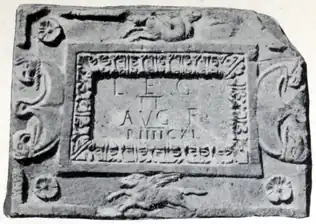| Second Legion Augusta | |
|---|---|
| Legio II Augusta Legio Secunda Augusta | |
 Map of the Roman empire in AD 125, under emperor Hadrian, showing the Legio II Augusta, stationed at Isca Silurum (Caerleon, Wales), in Britannia province, from AD 74 to at least 269 | |
| Active | 43 BC to sometime in the 4th century AD |
| Country | Roman Republic and Roman Empire |
| Type | Roman legion (Marian) |
| Role | Infantry assault (some cavalry support) |
| Size | Varied over unit lifetime. Approx. 3,500 fighting men + support at the time of creation. |
| Garrison/HQ |
|
| Nickname(s) |
|
| Patron | Augustus |
| Mascot(s) | Capricornus, in its sea-goat form the astrological sign of II Augusta's patron, Augustus |
| Engagements |
|
| Commanders | |
| Notable commanders |
|
Legio II Augusta (lit. Second Legion "Augustus'") was a legion of the Imperial Roman army that was founded during the late Roman republic. Its emblems were the Capricornus,[1] Pegasus,[2] and Mars. It may have taken the name "Augusta" from a victory or reorganization that occurred during the reign of Augustus.[3]

In Republican service
The Legio II, Sabina was a Roman military unit of the late Republican era, which may have been formed by Julius Caesar in the year of the consulate of 48 BC and coincide, in this case, with the Legio II. Enlisted to fight against Pompey, they took part in the subsequent Battle of Munda of 45 BC.
Alternatively it could be the Legio II, formed by the consul, Gaius Vibius Pansa in 43 BC and recruited in Sabina, hence its nickname.[4] If this theory is true, then it probably participated in the subsequent battle of Philippi of 42 BC on the side of the triumvirate, Octavian and Marc Antony.[5]
After the defeat of the Republicans, Legio II swore allegiance to Octavian[6] and with the same remained until the Battle of Actium of 31 BC,[7] after which it seems to have been dissolved in the years between 30 and 14 BC (sent on leave were between 105,000 and 120,000 veterans)[8] and some of its soldiers may have been integrated into the new Legio II Augusta.[6]
In Imperial service
Hispania
At the beginning of Augustus' rule, in 26 BC,[3] this legion was relocated to a place north of Hispania Tarraconensis, to fight in the Cantabrian Wars.[9] This war would definitively establish Roman power in Hispania. While the legion was in Hispania, they along with the Legio I Germanica helped build the Colonia Acci.[9] They also constructed the city of Cartenna.[3]
Germania and Gaul
With the annihilation of several legions at the Battle of the Teutoburg Forest, the Legio II Augusta moved to Germania, possibly in the area of Moguntiacum. While in Germania, during the 15 AD the legion would participate in the campaigns of Germanicus against the Germanic tribes.[9][3] After Germanicus was recalled the legion was stationed at Argentoratum.[9] On its way back from Germania, the legion was drenched in heavy rain and harassed by heavy storms.[3] After Julius Sacrovir and Julius Florus revolted against the Roman Empire in Gaul, the Legio II Augusta, under the command of Gaius Silius would help put down the revolt.[9][3]
Britain
Invasion of Britannia and Boudica's revolt
The legion was one of the four legions used during Claudius's invasion of Britannia.[9] The commander of the Legion at the time was Vespasian. He led the campaign against the Durotriges and Dumnonii tribes. During the campaign the Legion marched across the south of Britain, fighting many battles against the local tribes.[3]
The Legion was first stationed at Alchester and in 49 AD it was moved to Waddon Hill.[9] From 55 it was based at Exeter[10] and from 66 it was possibly at Glevum.[11]
During the uprising of queen Boudica, when its praefectus castrorum Poenius Postumus, who was then its acting commander possibly because its legatus and tribunes were with the governor Suetonius Paulinus, contravened Suetonius' orders to join him and so later committed suicide.[9]
Year of the Four Emperors
In 69 CE, during the Year of Four the Emperors, a vexillation of the Legio II Augusta sided with emperor Otho.[3] After Otho was defeated the vexillation switched sides and served Vitellius.[9] This vexillation possibly took part in Vetellius's march on Rome, and fought in the battle at Cremona against the legions of Otho.[9] Later these soldiers were defeated by those of Vespasian and returned to Britain in 70. It is possible that the main body of the legion had always been loyal towards Vespasian.[9]
Continued service in Britain
Julius Frontinus, the governor of Britain from 74 to 78 ordered several campaigns against the Silures tribe[3] and during the war the fortress of Caerleon in Wales was constructed where from 75 the legion was based.[9] The legion remained there, even during Agricola's term as governor of Britain. Although, several vexillations of the Legio II Augusta fought in the Battle of Mons Graupius.[3]
In 139 the Legion helped build the short lived Antonine Wall.[9] During the years 155 and 158 a revolt spread across Britain, the Legio II Augusta was one of those that fought against the revolt.[9] The legions in Britain suffered greatly, causing reinforcements from the Germanic provinces to be brought over.[9]
In 196 Decimus Clodius Albinus, governor of Britain, declared himself emperor and the Legio II Augusta supported his claim.[9] The legions were defeated by the current emperor, Septimus Severus. Although, while the legions were absent from Britain, the province was overrun with Pictish tribes.[9] Emperor Severus attempted to conquer Scotland in order to stop the tribes, while Severus was fighting the Picts, Legio II Augusta was stationed at a fort near Carpow.[9] It is unknown when, but the II Augusta received the surname Antonina, which meant that the soldiers were particularly dear to the emperor. This happened either under Caracalla or Heliogabalus,[9]
During Severus Alexanders reign as emperor of Rome, the conquests in Scotland were given up and the Second Legion returned to Caerleon.[9] The legion was still there in 255.[9] The last known mention of the Legion was the Notitia Dignitatum which places the legion at Richborough, suggesting Caerleon was abandoned.[3]
(Musée archéologique de Strasbourg)
Attested members
| Name | Rank | Time frame | Province | Soldier located in | Veteran located in | Source |
|---|---|---|---|---|---|---|
| Caius Largennius | miles | Germania | Argentoratum ? | Argentoratum |  | |
| Gaius Caetronius Miccio | legatus legionis | c. 34–36[18] | Germania Superior | CIL II, 2423 | ||
| Lucius Antistius Rusticus | tribunus | c. 69 | Britannia | AE 1925, 126 | ||
| Gnaeus Julius Agricola | tribunus | Britannia | ||||
| Gaius Fabius Agrippinus | tribunus | before 140 | Britannia | AE 1955, 174 | ||
| Publius Septimius Geta | tribunus | c. 170s | Britannia | |||
| Julius Marcellinus [19] | centurio [19] | Britannia [19] | Banna[19] | |||
| Poenius Postumus[20] | praefectus castrorum [20] | AD 60-61 | Britannia [20] | Glevum | Committed suicide out of shame following the battle of watling street. | Tacitus The Annals. 4.12; 14.37 |
| Titus Flavius Vespasianus | legatus legionis | AD 42-47 | Britannia | Italy | Rome | Suetonius Vesp. 4; Tacitus Hist. III 44; Josephius Bell. Jud. III 12 |
| Aulus Larcius Priscus | legatus legionis | between 97 and 105 | Britannia | CIL VIII, 17881 | ||
| Aulus Claudius Charax[21] | legatus legionis | c. 141-c. 144 | Britannia | AE 1961, 320 | ||
| Fronto Aemilianus Calpurnius Rufilanus[21] | legatus legionis | 161/169 or 177/180 | Britannia | CIL VII, 98 = RIB 320 | ||
| Quintus Aurelius Polus Terentianus[22] | legatus legionis | between 185 and 190 | Britannia | AE 1965, 240 | ||
| Lucius Julius Julianus | legatus legionis | end 2nd century | Britannia | CIL XI, 4182,CIL VII, 480 | ||
| Tiberius Claudius Paulinus | legatus legionis | early 3rd century | Britannia | CIL XIII, 3162 | ||
| Vitulasius Laetinianus | legatus legionis | between 253 and 259 | Britannia | CIL VII, 107 | ||
| Titus Flavius Postumius Varus | legatus legionis | 3rd century | Britannia | CIL VII, 95 | ||
| Lucius Valerius Geminus | AD 43-66 | Britannia | Alchester | |||
| Flavius Quadratus | aquilifer | ? | Hispania | Olisipo | CIL II, 266 = HEp 11, 2001 | |
| Titus Flavius Rufus | centurio | Italia, Moesia, Dacia | Dacia | CIL XI, 20 = ILS 2082, CIL III, 00971 |
In popular culture
- In his fantasy novel Grail, the author Stephen R. Lawhead states that the legion was ensnared by the black magic of the witch Morgan le Fay, doomed to perpetually wander the mists of Lyonesse.
- Lindsey Davis' character Marcus Didius Falco and his best friend Lucius Petronius Longus both served in the legion during Boadicea's Revolt in AD 60/61, while they were teenagers (probably 19–20 years old). Marcus and Lucius only refer to their service in asides, due to the bad memories of the Revolt and the boredom in a cold, unfriendly country. The scenes of carnage and destruction in Londinium left a deep impression on both of them, with neither keen to return to Britannia. Their internal references also hint that their disgraced prefect, Postumius, did not commit suicide, but instead was executed by the legionaries for his refusal to march to Governor Suetonius's aid during the Revolt, but the legionaries swore an oath never to speak of this to outsiders. Novels that most directly refer to their service in Britain are The Silver Pigs, The Iron Hand of Mars, A Body in the Bath House and The Jupiter Myth.
- It is also the Legion in which Optio Quintus Licinius Cato and Centurion Lucius Cornelius Macro serve during the first five books of the Eagles of the Empire series by Simon Scarrow. The books also cover Vespasian's career as commander of the legion and the invasion of Britain.
- The story of the legion's role in Boadicea's Revolt and the subsequent suicide of its acting commander features in Imperial Governor, George Shipway's 1968 novel about Gaius Suetonius Paulinus.
- The II Legion features in Adrian Goldsworthy's novel series, beginning with Vindolanda, about a fictitious centurion of the legion.
See also
References
- ↑ Legions and Veterans: Roman Army Papers 1971-2000 By L. J. F. Keppie page 128
- ↑ Legions and Veterans: Roman Army Papers 1971-2000 By L. J. F. Keppie page 129
- 1 2 3 4 5 6 7 8 9 10 11 "Legio II Augusta". World History Encyclopedia. Retrieved 2020-08-01.
- ↑ L.Keppie. The making of the roman army. pp. 199 and 203.
- ↑ E.Ritterling (1924–1925) [1483–1484]. voice Legio, in Realencyclopädie of Klassischen Altertumswissenschaft.
- 1 2 JRGonzalez. Historia del las legiones romanas. p. 106.
- ↑ L.Keppie. The making of the roman army. p. 201.
- ↑ Augustus. "Res Gestae Divi Augusti". III: 15 and 16.
{{cite journal}}: Cite journal requires|journal=(help) - 1 2 3 4 5 6 7 8 9 10 11 12 13 14 15 16 17 18 19 20 21 "Legio II Augusta - Livius". www.livius.org. Retrieved 2020-08-01.
- ↑ "Remains of Roman defences discovered under Exeter's Bus Station site". Exeter City Council. Retrieved 29 January 2020.
- ↑ G Webster, Rome against Caractacus, p 45, ISBN 0713472545
- ↑ "RIB 2203. Distance Slab of the Second Legion". Roman Inscriptions of Britain. Retrieved 18 November 2017.
- ↑ Macdonald, Sir George (1934). The Roman wall in Scotland, by Sir George Macdonald (2d ed., rev., enl., and in great part rewritten ed.). Oxford: The Clarendon press. pp. 386–387. Retrieved 11 October 2017.
- ↑ "Distance Slab of the Second Legion, Duntocher". 9 June 2017. Retrieved 14 November 2017.
- ↑ "RIB 2204. Distance Slab of the Second Legion". Roman Inscriptions of Britain. Retrieved 18 November 2017.
- ↑ Macdonald, Sir George (1934). The Roman wall in Scotland, by Sir George Macdonald (2d ed., rev., enl., and in great part rewritten ed.). Oxford: The Clarendon press. pp. 387–388. Retrieved 11 October 2017.
- ↑ "Distance slab of the 2nd Legion, Caerleith Farm, Duntocher". 30 March 2017. Retrieved 14 November 2017.
- ↑ Alföldy, Géza (1967). "Ein senatorischer Cursus honorum aus Bracara Augusta, CIL II 2423". Madrider Mitteilungen. 8: 185–195. ISSN 0418-9744.
- 1 2 3 4 "PVL Inscriptions - Birdoswald". Per Lineam Valli. 29 December 2013. Retrieved 2014-02-16.
- 1 2 3 "Legio II Augusta". Retrieved 2014-02-19.
- 1 2 Géza Alföldy, Konsulat und Senatorenstand unter der Antoninen (Bonn: Rudolf Habelt Verlag 1977), p. 298
- ↑ Anthony Birley, The Fasti of Roman Britain (Oxford: Clarendon Press, 1981), pp. 261f
Further reading
- livius.org account
- Field, N. (1992). Dorset and the Second Legion. Tiverton: Dorset Books. ISBN 1-871164-11-7.
- Keppie, Lawrence (2000). "The Origins and Early History of the Second Augustan Legion". Legions and Veterans: Roman Army Papers 1971-2000. Stuttgart: Franz Steiner Verlag. pp. 123–147. ISBN 3-515-07744-8.
External links
- LEGIO SECVNDA AVGVSTA, British 1st - 2nd century AD ~ Roman Living History Society
- LEGIO SECVNDA AVGVSTA FACEBOOK PAGE, Facebook Page for British 1st - 2nd century AD ~ Roman Living History Society
- LEGIO SECVNDA AVGVSTA (NL) Dutch 1st - 2nd century AD ~ Roman Living History Society
- Second Legion Augusta (NZ), New Zealand re-enactment group
- Richard Stillwell, ed. Princeton Encyclopedia of Classical Sites, 1976: "Abonae (Sea Mills, Bristol), England"
- Capricorn Rising: Astrology in Ancient Rome: Poetry, Prophecy and Power, article by David Wray. assistant professor of Classics, University of Chicago.



